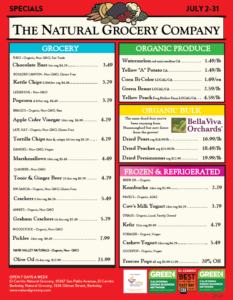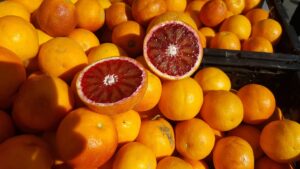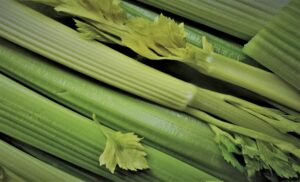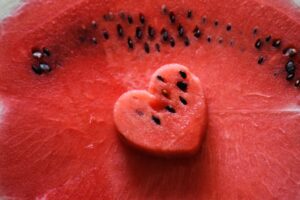2024 07 July Sales Flyer (larger print version)
April 2024 Sales Flyer
2024 04 April Sales Flyer (large print)
New Everyday Program!
You may notice some new signs on shelves throughout the store, and we want to make sure you know what they mean.
The Everyday signs showcase staples at everyday low prices. You can count on these high-quality essentials at an affordable price that means you can get them, well … every day if you want to! This program is one part of our broader efforts to make sure good food is accessible to all. With organic and non-GMO options, these are items you can feel good about buying and eating.
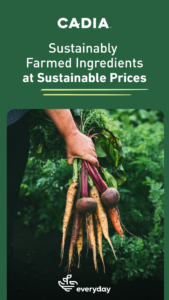 We know that eating healthy foods can sometimes feel like a luxury – especially if you’re on a tight budget. But with Everyday, you can shop with confidence, knowing that you’re getting the best value for your money. We believe that healthy eating should be accessible to everyone, and we’re committed to making that a reality.
We know that eating healthy foods can sometimes feel like a luxury – especially if you’re on a tight budget. But with Everyday, you can shop with confidence, knowing that you’re getting the best value for your money. We believe that healthy eating should be accessible to everyone, and we’re committed to making that a reality.
Taking part in the Cadia Everyday Program allows us to offer even lower prices to our customers on select Cadia items. We have lowered the prices on 95 Cadia items throughout the stores. Each item will be signed at the shelf to let shoppers know it’s an everyday deal. These prices will not change for at least three months. After three months, our suppliers may adjust some as necessary and then another three-month cycle will begin.
So why wait? Head to our stores today and start saving on all your grocery essentials. From frozen fruits and vegetables to snacks and pantry staples, we’ve got everything you need to eat well and feel great – at prices you’ll love.
At The Natural Grocery Company, we’re passionate about natural and organic food, and we’re excited to help you make healthy eating a part of your everyday routine. So come on in, shop around, and enjoy the benefits of new Everyday Program. We can’t wait to see you!
El Cerrito Natural Grocery Store Wins “Best Natural Foods Store” in the East Bay Express 2023 Best of the Bay Reader’s Poll
Voting Open for EBX Best of The Bay
In Local News…
It’s all about us!
The Richmond Standard is talking about The Natural Grocery Company, our origins and evolution. Check out the article.
More About “Moro” Blood Oranges
Organic “Moro” Blood Oranges on sale in January 2023 for $2.59/lb
“Moro” blood oranges have a rind that is orange, kissed with red blush, and has a leathery texture, pebbled with prominent oil glands. Underneath the surface of the rind, there is a medium-thick pith that is white, spongy, and tightly adhered to the flesh. The flesh ranges in color from orange with red blush, to maroon, crimson, to a saturated, almost black hue, depending on the climate that it is grown in. The flesh is also soft, juicy, and nearly seedless, divided into 10-11 segments by thin membranes. Moro blood oranges have a slightly sweet, floral fragrance and a sweet-tart taste with notes of cherries and raspberries. The oranges with the deepest pigmentation will exhibit more intense sweet berry notes characteristic to blood oranges.
Moro blood oranges, botanically classified as Citrus sinensis, are an early season Italian variety that grows on a highly ornamental, evergreen tree that belongs to the Rutaceae or citrus family. Their color is due to a pigment called anthocyanin, not usually present in citrus but common in other red fruits and flowers. Fluctuations in temperature greatly affect the degree to which blood oranges develop their characteristic blush. Though the Moro can vary greatly in this respect, no other blood orange variety is known to exhibit such deeply red colored fruits.
Moro blood oranges are a good source of vitamin C, potassium, folate, thiamine, dietary fiber and most notably antioxidants supplied by its anthocyanin content.
Moro blood oranges are both intensely flavored and colored, adding a unique citrus flavor as well as visual appeal to a dish. They are often used raw and can be sliced and mixed into parfaits, desserts, salads, salsa, and garnished over seafood and poultry. Moro blood oranges also stand up well in cooked applications and may be paired with sweet or savory flavors. Moro blood orange juice can also be served as a stand-alone juice, used in cocktails with prosecco, cooked into syrups, sorbets, marmalades, compotes, sauces, and vinaigrettes, or used to flavor cheesecake, pound cake, or muffins. Moro blood oranges pair well with meats such as duck, poultry, pork, and seafood such as Mahi Mahi, other citrus, mint, tarragon, soft cheeses, shallots, arugula, roasted beets, fennel, shallot, Dijon mustard, Greek yogurt, honey, rolled oats, pistachios, sweetened coconut, mango, cinnamon, avocado, ginger, lime, mint, and cilantro.
They will keep up to one week when stored at room temperature and up to two weeks when stored in the refrigerator.
Organic Celery
Season: Grown in California and available year-round.
Flavor: Celery has a mild and strong taste at the same time, giving it a bold flavor. It can remind you of raw or green onions in a way, with an earthy taste. It can also taste unpleasant to some people and has a plant-like taste much like lettuce and kale does.
Choosing & Storage: It’s a not good idea to keep celery at room temperature for more than a few hours at a time. If you want to avoid celery from going bad, you will need to use a storage bag and make sure it stays in the refrigerator less than five days. Don’t keep celery for too long since it will start to rot. The vegetable crisper is your safest bet, but it would be a good idea to use an airtight container as well. Celery (especially if cut) has a strong smell and may contaminate other foods, so be mindful.
How to use: Fresh – with peanut butter for snacking or finely chopped and added to potato salad, egg salad or tuna salad. Cooked in soups and stews. Juice and drink it fresh by itself or combine with other fruits or vegetables.
Nutrition: Celery is mainly made up of water, but it also provides dietary fiber. Beyond apigenin and luteolin, celery contains other plant compounds that have powerful antioxidant properties, selinene, limonene, kaempferol, p-coumaric acid. Celery also provides small amounts of vitamin K, folate, vitamin A, potassium, and vitamin C.
Organic Bananas
Season: They’re native to Southeast Asia but grown in several countries near the equator and are available year-round.
Flavor: Bananas have an interesting flavor transition during their ripening process. Unripe bananas which still contain the green peel have a bland flavor with apparent notes of grassiness. Furthermore, less ripe bananas contain higher levels of starch and therefore have a “starchier” taste. As they ripen a more distinctive fruity flavor develops accompanied melon, pineapple, candy and clove flavor notes. Yellow bananas have higher sugar concentrations and therefore taste sweeter. Finally, when the peel has become brown, the banana contains notes which are reminiscent of vanilla, honey and rum.
Choosing & Storage: Look for plump, firm, and brightly colored bananas. Occasional brown spots on the skin are normal. Avoid sunken, moist-looking dark areas, split skins or stems.
Bananas that require ripening should be left at room temperature, but away from heat or direct sun. To speed ripening, place them in a closed paper bag. Once ripe bananas can be held at room temperature for a day or two. Refrigerate to slow down ripening. Although the skins will turn dark, the fruits will remain edible. Keep refrigerated bananas for up to two weeks. Do not refrigerate unripe bananas because the exposure to cold interrupts their ripening cycle.
How to use: Eat them fresh! Bake them into “banana bread”. Use to thicken and sweeten smoothies. Dip in melted chocolate, roll in nuts and freeze for a sweet frozen treat.
Nutrition: Bananas are a healthy source of fiber, potassium, vitamin B6, vitamin C, and various antioxidants and phytonutrients. Vitamin C, Riboflavin, Folate, Niacin, Copper, Potassium, Magnesium.
Organic Red Watermelon
Season: July & August are the height of watermelon season in California. Watermelons are native to Africa.
Flavor: A watermelon is a large fruit that is green and striped on the outside and red and juicy on the inside. It is a very sweet, fresh, green and fruity taste with cucumber notes. It has a soft, crisp flesh.
Choosing & Storage: When choosing a watermelon, obviously you want to avoid any that show signs of decay, but that yellow spot – as long as it’s not mushy – merely shows where that watermelon ripened in the field and it’s perfectly fine. Ripe watermelons make a dull thud when you tap them with your fingers.
Place melons in a cool, shady spot or put them on ice. Watermelons can be stored uncut and unrefrigerated for about 10 days to 2 weeks. Place them in a very cool place to increase their storage time. If cut, watermelon will keep in the refrigerator for about 4 days wrapped tightly in plastic. Once refrigerated, they should remain refrigerated.
How to use: Fresh, eaten as is! Try grilling it and adding to salads or salsa. It’s easy to juice for a sweet summer drink. I like to add a bit of lime juice to balance the sweet!
Nutrition: This fruit is a good source of vitamin C, potassium, copper, vitamin B5, and vitamin A.


